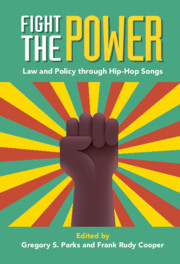Book contents
- Fight the Power
- Fight the Power
- Copyright page
- Dedication
- Contents
- Contributors
- Acknowledgments
- Introduction Still Fighting the Power
- Part I Policing
- 1 From “Fuck tha Police” to Defund the Police: A Polemic, with Elements of Pragmatism and Accommodation, Hopefully Not Fatal, As Black People Hope About Encounters with the Police
- 2 Hip-Hop and Traffic Stops
- 3 “Black Cop”: It’s a Blue Thing (or Is It?)
- 4 “Illegal Search”: Race, Personhood, and Policing
- 5 “Cops Shot the Kid”: Police Brutality, Mass Incarceration, and the Reasonableness Doctrine in Criminal Law
- Part II Imprisonment
- Part III Genders
- Part IV Protests
- Index
5 - “Cops Shot the Kid”: Police Brutality, Mass Incarceration, and the Reasonableness Doctrine in Criminal Law
from Part I - Policing
Published online by Cambridge University Press: 20 January 2022
- Fight the Power
- Fight the Power
- Copyright page
- Dedication
- Contents
- Contributors
- Acknowledgments
- Introduction Still Fighting the Power
- Part I Policing
- 1 From “Fuck tha Police” to Defund the Police: A Polemic, with Elements of Pragmatism and Accommodation, Hopefully Not Fatal, As Black People Hope About Encounters with the Police
- 2 Hip-Hop and Traffic Stops
- 3 “Black Cop”: It’s a Blue Thing (or Is It?)
- 4 “Illegal Search”: Race, Personhood, and Policing
- 5 “Cops Shot the Kid”: Police Brutality, Mass Incarceration, and the Reasonableness Doctrine in Criminal Law
- Part II Imprisonment
- Part III Genders
- Part IV Protests
- Index
Summary
Kristin Henning uses Nas’s 2018 song “Cops Shot the Kid” to make a case that the crisis in racist American policing begins with its children. The heartrending and evocative song features Kanye West and samplings from Slick Rick’s 1989 song “Children’s Story” and Richard Pryor’s 1973 film Wattstax. Nas’s theme is cogent and his lyrics powerfully capture what every black child knows—“white kids are brought in alive, black kids get hit with like five.” That is five bullets for normal summer adolescent fun like “slap-boxin’ in the street, crack the hydrant in the heat.” As Nas says “I don’t wanna hurt nobody. We just came here to party. See a few dames, exchange some names.” And yet he knows, every black child can expect to be criminalized, harassed, and even killed for doing what teenagers do all over the world—flirting with girls, rough-housing with their friends, sagging their pants, playing with toy guns, going to parties, laughing, and defying “authority.” Just as white youth are given the freedom to test boundaries and experiment with sex and drugs, black youth are treated as a threat to white America and deprived of the fundamental benefits of healthy adolescent development.
Keywords
- Type
- Chapter
- Information
- Fight the PowerLaw and Policy through Hip-Hop Songs, pp. 101 - 124Publisher: Cambridge University PressPrint publication year: 2022



